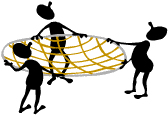Assessing Groups
 Most professionals–of any profession–recognize the importance of working in teams and groups. There are many who claim that the rising use of social media, despite its name, is actually causing an isolation among users (see Ilardi; Turkle). Whether you agree with that statement or not, there are few working adults who function as sole practitioners without interacting with others in and across their disciplines. It is important, therefore, that educators teach and model best practices for functioning effectively and efficiently in teams.
Most professionals–of any profession–recognize the importance of working in teams and groups. There are many who claim that the rising use of social media, despite its name, is actually causing an isolation among users (see Ilardi; Turkle). Whether you agree with that statement or not, there are few working adults who function as sole practitioners without interacting with others in and across their disciplines. It is important, therefore, that educators teach and model best practices for functioning effectively and efficiently in teams.
First Steps
- Group assignments should be those that truly can only be accomplished by working together; too often group work is composed of components completed by each individual member, compiled in some fashion then submitted as a group work process. If your purpose is to teach collaboration and cooperation, then the assignment must require that.
- You should ensure that students understand the objective(s) of group assignments. When students feel they are being assigned group work simply for the sake of working in a group, they view it as busy-work and fail to engage.
- In addition to research that shows that group interaction improves learning, effective team work is also a skill that research shows is highly valued by employers (Half).
- Online learners are often non-traditional students who are also working professionals. This makes group work difficult at time as varied schedules are juggled. As faculty, it is important, therefore, that you facilitate group work by ensuring that there resources available such as discussion and collaborative areas and document-creation functionality such as EtherPad or GoogleDrive in which they can work. File sharing can also be used with Box or often with your CMS.
An Idea for your Course
The University of Kent has created an excellent teamworking skills website. Consider adding this as required reading before a major team project, particularly if your learners may not have a lot of experience with team assignments. The site includes a great exercise that learners can do to help them see their strengths and weaknesses as members of a team
Purpose of Assignment
Many of us are comfortable assigning students to groups or letting them self-select but stumble when it comes to assessing those groups. The Eberly Center for Teaching Excellence & Educational Innovation states that group work has multiple purposes that an instructor may want to assess. For example, are you evaluating:
- The end product?
- The group process?
- A combination of the two?
So, the first step you must take is to be clear in your mind why you are having the students work in teams and what end result you are hoping to achieve. Only then can you decide the assessment strategies to employ.
Assigning the Score
In the end, you must assign an individual grade. How you arrive at that individual grade is something you need to consider carefully. Will you assign
- Individual scores for individual components for which an individual was responsible?
- A single score for the group wherein each member gets the same grade regardless of effort or responsibility within the group?
- Scores based totally or partially on input from group members?
The Centre for Teaching Excellence published ideas for assessing group work. Western Univeristy in Canada provides this page on best practices for assessing group work. Additionally, the Assessing Group Work in Online Courses blog contains several ideas for group work including links to many rubrics.
The next strategy we will discuss is portfolios.
